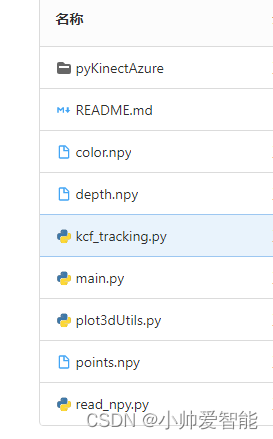本项目使用python-opencv打开Azure-Kincet DK相机,并显示RGB,深度图和点云图和KCF目标跟踪算法
附上实现的代码地址与已经测试成功的系统
本文代码地址:open_azure_kinect
已经测试成功的操作系统:windows10,和jetson-nano(Ubuntu)。
参考文章:1.最新一代Kinect DK的python接口实现(深度图+RGB+IMU)
2.基于Azure Kinect DK相机的安装配置,获取并保存RGB、Depth、IR图、点云,点云融合(Windows)
3.Azure Kinect DK 深度相机,Ubuntu 18.04系统安装SDK
4.Ubuntu18.04下Azure Kinect DK 调试(SDK源码+ROS)无比详细踩坑教程
5.python调用opencv库中的KCF等跟踪算法
一、在系统上安装Azure Kinect 传感器 SDK (Windows或linux)
Azure Kinect 传感器 SDK 下载,官方说明文档:Azure Kinect 传感器 SDK
linux上安装所需文件如下图安装参考文章3和4连接(https://blog.csdn.net/denkywu/article/details/103177559):

安装完成后,将相机插入电脑USB3.0接口,若为windows系统 则在开始菜单下找到Azure Kinect SDK v1.4.1,然后点击打开,能搜索到设备并成功启动即可。若为linux系统,则在安装完成后,执行
sudo ./k4aviewer
命令即可打开相机。
二、环境配置
ctypes:读取底层库
numpy
opencv-python
open3d:用来显示点云图
这里大家可以根据网上的相关教程进行配置。安装教程很多,并不复杂。
三、完成显示和跟踪功能
这是本次项目中用到的文件,下面对这几个文件分别做一个介绍。

首先,pyKinectAzure文件夹中都是为打开相机所调用的python接口函数,这里主要参考了大佬代码:
https://github.com/ibaiGorordo/pyKinectAzure
ps:对于有些源码看不懂可以看微软c的源码:
https://microsoft.github.io/Azure-Kinect-Sensor-SDK/master/structk4a__device__configuration__t.html
kcf_tracking.py实现kcf算法的目标跟踪;plot3dUtils.py是绘制点云图;三个.npy文件分别保存了RGB、深度图以及点云图的信息,read_npy.py文件就是读取这三个文件并显示图像;main.py是主函数,程序运行这一个文件即可实现显示与跟踪功能。
main.py主函数代码如下(注意windows和linux系统中Azure Kinect SDK 路径的区别):
import sys
import numpy
sys.path.insert(1, './pyKinectAzure/')
import numpy as np
from pyKinectAzure import pyKinectAzure, _k4a
import cv2
import kcf_tracking
# 添加 Azure Kinect SDK 路径
modulePath = 'C:\\Program Files\\Azure Kinect SDK v1.4.1\\sdk\\windows-desktop\\amd64\\release\\bin\\k4a.dll'
#modulePath = r'/usr/lib/aarch64-linux-gnu/libk4a.so' 对于linux系统的SDK路径
import plot3dUtils
#对获取的深度图像进行颜色处理
def color_depth_image(depth_image):
depth_color_image = cv2.convertScaleAbs(depth_image,
alpha=0.05) # alpha is fitted by visual comparison with Azure k4aviewer results
depth_color_image = cv2.applyColorMap(depth_color_image, cv2.COLORMAP_JET)
return depth_color_image
def save_npy(color_image_list1,depth_image_list2,points_list3):
a = numpy.array(color_image_list1)
b = numpy.array(depth_image_list2)
c = numpy.array(points_list3)
numpy.save('color.npy', a)
numpy.save('depth.npy', b)
numpy.save('points.npy', c)
def display_all():
# 初始化
pyK4A = pyKinectAzure(modulePath)
pyK4A.device_open()
device_config = pyK4A.config
device_config.color_format = _k4a.K4A_IMAGE_FORMAT_COLOR_BGRA32
device_config.color_resolution = _k4a.K4A_COLOR_RESOLUTION_720P
device_config.depth_mode = _k4a.K4A_DEPTH_MODE_WFOV_2X2BINNED
print(device_config)
# 开启摄像头
pyK4A.device_start_cameras(device_config)
#获取相机序列号
serial_number=pyK4A.device_get_serialnum()
print(serial_number)
k = 0
open3dVisualizer = plot3dUtils.Open3dVisualizer()
list1=[] #保存RGB图像
list2=[] #保存深度图像
list3=[] #保存点云图
encode_param = [int(cv2.IMWRITE_JPEG_QUALITY), 30]
while True:
# Get capture
# starttime = time.time()
pyK4A.device_get_capture()
# 获取深度图像
depth_image_handle = pyK4A.capture_get_depth_image()
# 获取RGB图像
color_image_handle = pyK4A.capture_get_color_image()
# print(depth_image_handle)
# 将深度图转为点云图
point_cloud = pyK4A.transform_depth_image_to_point_cloud(depth_image_handle)
# print(1)
# 检查图像是否读取成功
if depth_image_handle and color_image_handle:
# 将获取到的图像转换为nummpy矩阵
color_image = pyK4A.image_convert_to_numpy(color_image_handle)[:, :, :3]
depth_image = pyK4A.image_convert_to_numpy(depth_image_handle)
ret, point_cloud_image = pyK4A.image_convert_to_numpy(point_cloud)
points = point_cloud_image
points = points.reshape((-1, 3))
depth_image = color_depth_image(depth_image)
list1.append(color_image)
list2.append(depth_image)
list3.append(points)
# 图像显示
open3dVisualizer(points)
cv2.namedWindow(' Color Image', cv2.WINDOW_NORMAL)
cv2.imshow(' Color Image', color_image)
cv2.namedWindow(' Depth Image', cv2.WINDOW_NORMAL)
cv2.imshow(' Depth Image', depth_image)
k = cv2.waitKey(25)
if k == 27: # Esc
break
pyK4A.image_release(depth_image_handle)
pyK4A.image_release(color_image_handle)
pyK4A.capture_release()
save_npy(list1, list2, list3)
pyK4A.device_stop_cameras()
pyK4A.device_close()
def track():
pyK4A = pyKinectAzure(modulePath)
pyK4A.device_open()
device_config = pyK4A.config
device_config.color_format = _k4a.K4A_IMAGE_FORMAT_COLOR_BGRA32
device_config.color_resolution = _k4a.K4A_COLOR_RESOLUTION_720P
device_config.depth_mode = _k4a.K4A_DEPTH_MODE_WFOV_2X2BINNED
print(device_config)
# 开启摄像头
pyK4A.device_start_cameras(device_config)
# 获取相机序列号
serial_number = pyK4A.device_get_serialnum()
print(serial_number)
k = 0
# 选择 框选帧
print("按 n 选择下一帧,按 y 选取当前帧")
while True:
# Get capture
pyK4A.device_get_capture()
# Get the depth image from the capture
depth_image_handle = pyK4A.capture_get_depth_image()
# Get the color image from the capture
color_image_handle = pyK4A.capture_get_color_image()
# Check the image has been read correctly
if depth_image_handle and color_image_handle:
# Read and convert the image data to numpy array:
color_image = pyK4A.image_convert_to_numpy(color_image_handle)[:, :, :3]
# depth_image=pyK4A.image_convert_to_numpy(depth_image_handle)
# depth_image=color_depth_image(depth_image)
_key = cv2.waitKey(0) & 0xFF
if (_key == ord('n')):
color_image_handle = pyK4A.capture_get_color_image()
color_image = pyK4A.image_convert_to_numpy(color_image_handle)[:, :, :3]
if (_key == ord('y')):
break
# cv2.namedWindow(' Color Image', cv2.WINDOW_NORMAL)
color_image = cv2.resize(color_image, (1280, 720))
cv2.rectangle(color_image, (30, 30), (100, 100), (255, 0, 0), 2, 1)
cv2.imshow(' Color Image', color_image)
# cv2.namedWindow(' Depth Image', cv2.WINDOW_NORMAL)
# cv2.imshow(' Depth Image', depth_image)
k = cv2.waitKey(25)
if k == 27: # Esc
break
pyK4A.image_release(depth_image_handle)
pyK4A.image_release(color_image_handle)
pyK4A.capture_release()
cv2.destroyWindow("pick frame")
gROI = cv2.selectROI("ROI frame", color_image, False)
if (not gROI):
print("空框选,退出")
quit()
gTracker = kcf_tracking.Tracker(tracker_type="KCF")
gTracker.initWorking(color_image, gROI)
while True:
# Get capture
pyK4A.device_get_capture()
# Get the color image from the capture
color_image_handle = pyK4A.capture_get_color_image()
if color_image_handle:
color_image = pyK4A.image_convert_to_numpy(color_image_handle)[:, :, :3]
color_image = cv2.resize(color_image, (1280, 720))
_item, p1, p2 = gTracker.track(color_image)
cv2.imshow("track result", _item.getFrame())
if _item.getMessage():
# 打印跟踪数据
print(_item.getMessage())
else:
# 丢失,重新用初始ROI初始
print("丢失,重新使用初始ROI开始")
gTracker = kcf_tracking.Tracker(tracker_type="KCF")
# gTracker = Tracker(tracker_type="MOSSE")
gTracker.initWorking(color_image, gROI)
_key = cv2.waitKey(1) & 0xFF
if (_key == ord('q')) | (_key == 27):
break
if (_key == ord('r')):
# 用户请求用初始ROI
print("用户请求用初始ROI")
gTracker = kcf_tracking.Tracker(tracker_type="KCF")
# gTracker = Tracker(tracker_type="MOSSE")
gTracker.initWorking(color_image, gROI)
# pyK4A.image_release(depth_image_handle)
pyK4A.image_release(color_image_handle)
pyK4A.capture_release()
pyK4A.device_stop_cameras()
pyK4A.device_close()
if __name__ == '__main__':
display_all()
#track()